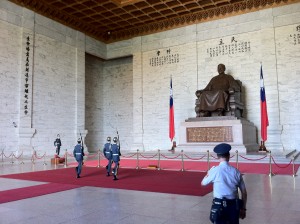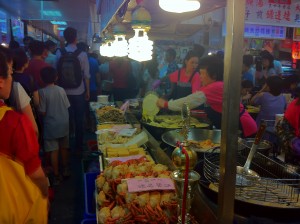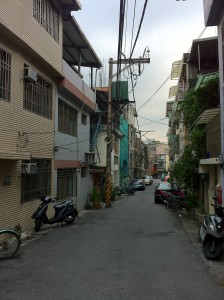How is it that I am already getting behind on updates and I have been here just over a week? But on second thought, there is some sense in that: a lot of things have been happening are for the first or only time, and thus merit some reflection. I think things will settle down into some regular rhythms eventually, and it will feel like I have less to report on.
Last weekend was the Fulbright orientation, which was some part technicalities (reviewing the fine print of the grants that we received, meeting everyone in the office that is most directly responsible for us – ie. whom we should go running to if we encounter bureaucratic tangles about our status in Taiwan), but also some parts fun. We got to meet all of the other Americans who are in Taiwan for similar reasons, although there’s no shortage of Americans to connect with here, it still gives a bond of some similarity. Still, I think that although the Fulbright commission wants us to form a community between grant recipients, given the diversity of work that we are doing and the fact that we’re spread out across the country, and the diversity of recipients in general, it’s not going to be a tightly knit group across all of the grantees.
Regardless of whether or not we had a lot in common, I appreciated the chance to get to see who else is here on the joint dime of US and Taiwanese government money and what they are going to be trying to accomplish. There’s (what seems like) a hoard of English Teaching Assistants (ETA’s), whose (if I may generalize broadly) purpose in this country is to be young, fun Americans teaching English in semi-remote or otherwise somewhat disadvantaged schools. To further generalize broadly about their goals, it seems that they are here to be young, fun Americans in a foreign country (sometimes very specifically Taiwan). And to conclude my broad generalizations about them, there didn’t seem to be anything too complicated about what they will be doing here.
More interesting were some of the other grantees, both in their stories behind what they are going to be doing here and what they intend to do. As I mentioned previously, there is actually a great diversity in the scholars who receive awards from the Fulbright. Sitting around the table were tenured professors with children older than myself; me, fresh from undergrad and probably obviously bright-eyed and bushy-tailed; and then a range of PhD candidates and assistant professors in between. (I think I might actually be the low-outlier of experience. But, hey, it has to be someone, and I don’t exactly have time to run off and go get a master’s degree, so I’ll just do my best and roll with it.) The variety specialties was also broad, from new music composition to using graphics processing units (GPU’s) for faster computer processing, to analyzing ancient texts, to aboriginal education systems…
But what really struck me, was the relationships that everyone had with Taiwan. Everyone had a personal connection to the island in some way. While this was likely something that the selection committee had in mind as a criteria to select candidates, I was still appreciative of the forms that this took. Some had attained American citizenship after immigrating from Taiwan years ago; others had grown up on the island as ex-pats and have now returned to understand their childhood home in a different light. There were also family connections: parents who had been born here (like me), or those who had married into Taiwanese families. Even with other Americans (non-Fulbrighters) that I’ve run into since being here, it’s pretty common that the reason they have returned to this relatively small corner of the globe because of some kind of connection like the ones listed above. And that’s not surprising: Taiwan probably became a relatively international community with the waves of emigration during the last century. In fact, an entire separate category of passports for “overseas Chinese”, who may have never even been to Taiwan itself, but want to claim their heritage and their relationship. Furthermore, the Taiwanese government has been open to other countries than mainland China for much longer, leading to the higher possibility of a foreigner who can tell stories of Taiwan in the 1970’s and is returning to the island after a hiatus.
I won’t claim to really know the influence that this has on Taiwan’s interesting place the international arena – which may be some soft power or nothing at all. I would say, that the in the common introduction that foreigners exchange, “what is your connection to this place”, in Taiwan it often extends beyond business.
Another part of the Fulbright orientation was a whirlwind tour of some cultural and historical highlights of Taipei. Unfortunately, most of the stops were just long enough to start to digest what the significance of the location. Thankfully, I’m sure that I’ll have the chance to revisit most of these places with friends or family if they decide to visit. Most of the sites were free, so I’ll just have to find people to go with to revisit them.

Some of the other recipients of the same grant that I received,( the Fulbright Student research grant, although we’re being deemed “Fellows” by the commission here in Taiwan) and I then hit up the Shilin night market together at the end of the orientation activities. Night markets in Taiwan are probably everything that you would want and expect from a market on the street at night in Asia: bustling with people, food, blinking lights, wares of all kinds, smells, open arcades, and things to look at everywhere. Except, unlike the similar places that I’ve been in mainland China, I don’t find myself struggling with as many negative thoughts, like: “why don’t these people think this is kind of gross…?” “this really is just too many people!” “that ___ looks so cheap that I can’t believe that it’s worth buying at any price – even that ridiculously low one.” I’m not saying that they aren’t full of semi-hygenic food and cheap goods from mainland China, but just to a lesser extent than I’ve seen before.

Taiwanese cuisine is often aiming for something referred to as QQ, which is a gummy-chewy texture. Food blogs of the internet have discussed this in more detail than I care to, but just think of boba, or the pearls of tapioca in bubble tea and you get the idea. Night markets are a prime place to go looking for QQ food. I started out enticed by the idea of getting something gummy to chew on as “food” and now have been completely won to the concept that it is an excellent idea.
On that note, I’m going to end this epically long post. I still have more to report (an entire week, in fact), but I’ll just end here for now.
